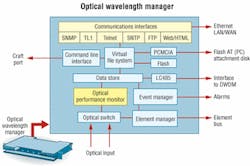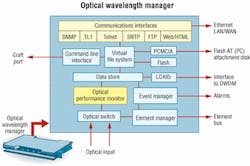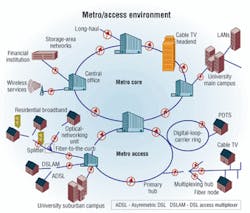Intelligent optical transport yields better profits
As dumb pipes and reactive management give way to intelligent optical transport and preemptive management, metro service providers will reap the benefits of profitable networks.
WILLIAM EMKEY, Lightchip
DWDM has proven ideal for long-haul communications. Rather than installing more fiber into the ground, long-haul carriers have been increasing installed-fiber bandwidth capacity by adding wavelengths to existing fiber. As a result, WANs have gained an economic bandwidth boost through the deployment of DWDM.
In MANs, DWDM plays a more complex role. Along with increasing bandwidth, DWDM systems also provide the flexibility required to meet the dynamic needs of the metro environment. But to take advantage of the power these networks provide, DWDM must be cost-effective and highly reliable.
Today, incremental costs in the metro are dominated by such expensive optoelectronics as SONET add/drop multiplexers, optical-electrical-optical (OEO) conversions, and active optics-lasers, receivers, and amplifiers. A major force behind the movement to all-optical networks (AONs) is the incorporation of solutions that address these cost issues. As DWDM optical networks evolve, it is apparent that a critical enabler is the ability to manage the optical transport layer at the wavelength level, a requirement that fails in current protocol-level network management.
Network-management solutions, although satisfying the needs of the long-haul environment, currently do not meet metro cost objectives due to costly required OEO operations. In addition, traditional management systems fall short of performance requirements, since they provide little or no visibility into the status and health of the wavelength channels. Traditional management systems do not provide the critical information about optical-channel power, channel wavelength, and optical-signal-to-noise ratio (OSNR) of carrier wavelengths within the transport layer.Instead, the optical transport layer is treated as a series of "dumb pipes," adding little or no value to overall network intelligence or management. This condition is rapidly changing. Metro service providers require an intelligent solution that, in addition to reducing dependence on expensive electronics and active optics, provides for proactive measurement and management of individual wavelength channels across the network.
Wavelength monitoring and management are the foundation of effective deployment of DWDM systems, providing crucial building blocks for the evolution of AONs. By distributing this capability to critical nodes throughout the network, service providers can centrally assess optical transport layer quality at the wavelength level. This capability adds intelligence at the optical transport layer, resulting in a reduction of direct capital and operating costs and increased revenues, due to its predictive failure capability. Thus, wavelength management enables metro-area service providers to deploy DWDM networks that provide profitable and enhanced network service creation, delivery, and maintenance.
Intelligent optical transport requires treatment of the optical transport layer as a network, one that demands management at the photonic level. Wavelength management begins with the ability to monitor all wavelengths transmitted within the transport layer, with optical channels monitored for such key optical parameters as wavelength, power, and OSNR. The process of taking measurements must be non-intrusive, reliable, accurate, and rapid.
The ability to efficiently monitor each wavelength channel is only the first step. To achieve intelligent optical transport layer performance thresholds, optical parameters at each critical node need to be established, as prescribed by optimizing overall network performance. The parameters are assessed locally or remotely against prescribed performance. The networking of monitors into a network operations center (NOC) closes the loop, enabling distributed management of wavelengths throughout the transport layer.
The ability to deploy integrated wavelength monitoring and management throughout a network exists today (see Figure 1). Within the optical wavelength manager (OWM) is an optical-performance-monitor (OPM) module, with built-in intelligence, to measure and report key optical parameters of wavelength, power, and OSNR. To meet all necessary monitoring requirements, the non-intrusive OPM uses a sensitive detector array, requiring less than half of 1% of tapped optical power.
All wavelengths are simultaneously displayed onto a detector array, providing rapid parallel readout. Using a 100% solid-state design and no moving parts enhances the robustness and reliability of the unit. The result is a reliable network element that reports in tens of milliseconds the status of all channel parameters. Other elements within the OWM use these parameters to establish or trigger alarms as well as log data for performance trend assessment. The OWM is also capable of being easily integrated into standard network operating systems such as SNMP and TL1.By enabling unprecedented control of individual wavelengths, the intelligent optical transport layer allows metro service providers to preemptively address problems discovered by the wavelength-management system (see Figure 2). In a simple DWDM link, OWMs establish a distributed management network using standard communication links to interconnect critical nodes and a centralized NOC, whereby the status of the transport layer (i.e., the health of all wavelength channels) is immediately available locally and remotely.
Any degradation of channel performance, such as wavelength drift, optical power variation, or OSNR reduction, is immediately detected, reported, and alarmed at user-defined thresholds. Degradation may be caused by laser aging, premature laser deterioration, a change in optical element performance (such as optical filter drift), an increase in system noise (often associated with optical amplifiers), and optical loss variation within the fiber plant.
Based on the distributed nature of the wavelength-management network, the NOC is able to identify the specific channel and location affected, allowing immediate corrective action to take place long before a traditional management system even detects a problem. Such preemptive discovery enables carriers to address performance problems before customers experience service interruptions. Taking action before customers experience a problem enables metro service providers to avoid downtime and customer churn-elements crucial to profitability.The expansion of a simple DWDM link into a realistic metro-area network reinforces the need for wavelength management (see Figure 3). Within DWDM metro systems, wavelengths can be flexibly provisioned to connect many users throughout the network. Because wavelengths are selectively added, dropped, or expressed, as they traverse segments of the network, real-time continuous visibility into the transport layer is imperative. That is particularly evident for wavelengths expressed through several nodes. In such cases, the simple monitoring of signals, when received at the endpoints, as with traditional monitoring systems, creates dangerous network "blind spots." The incorporation of costly protocol-level monitoring systems or adding SONET ADMs are not viable solutions, since they are cost-prohibitive.
The migration to OANs exacerbates the problem by effectively increasing network blind spots. Consequently, solving a transport-related network failure necessitates a time-consuming search for failure points, requiring a series of expensive truck-rolls.
Fortunately, distributed OWM-managed networks overcome this challenge by cost-effectively providing a high-level continuous performance assessment, at all critical points in the network. Moreover, given the distributed nature of wavelength monitoring, OWM-managed networks also provide fiber loss information on the fiber plant between network monitoring points.
DWDM is at the core of metro carriers' strategies to market wavelengths in bulk or as bandwidth-on-demand. These networks also provide a foundation for such bandwidth-intensive services as video-on-demand and SAN transport. For metro optical networks to realize their full potential as dynamic service delivery platforms, where wavelengths are flexibly provisioned throughout the network, intelligent optical transport solutions are critical. The key to delivering intelligence is the establishment of a distributed wavelength-management network, capable of monitoring and managing wavelengths at critical nodes throughout the network. It is also important that wavelength management be deployed early in the evolution of these systems. Early adoption paves the way for large-scale DWDM deployment by providing early cost and performance benefits. Intelligent OWMs reduce the number of OEO conversions and provide immediate visibility into the status of all the wavelength channels-critical first steps in the creation of an intelligent optical transport layer.
Visibility into transport layer performance enables providers to cost-effectively manage their networks and improve the quality of services.
William Emkey is vice president of product marketing at Lightchip (Salem, NH). He can be reached via the company's Website, www.lightchip.com.



